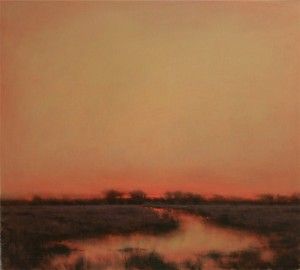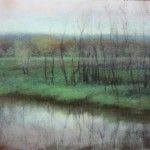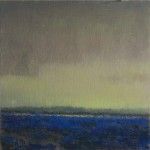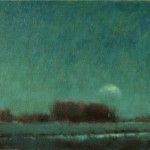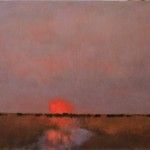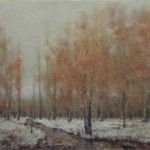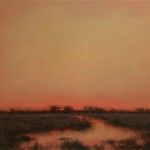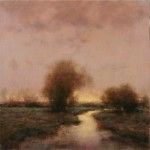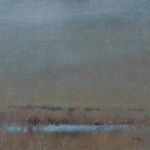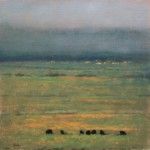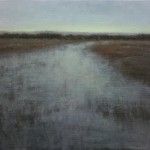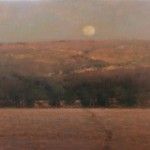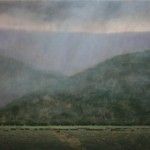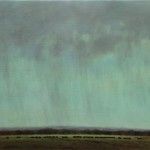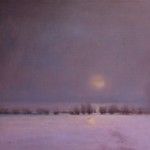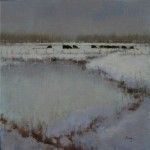Nancy Bush, Autumn Twilight, oil, 36 x 40.
Landscape artist Nancy Bush captures nature’s quiet, swiftly shifting moods
By Norman Kolpas
This story was featured in the May 2013 issue of Southwest Art magazine. Order the Southwest Art May 2013 print issue, or get the Southwest Art May 2013 digital download now…Or better yet, just subscribe to Southwest Art and never miss a story!
One evening last fall, Nancy Bush set out by car from her home in the arts community of Fredericksburg, the thriving heart of the Texas Hill Country. She had one goal in mind: capturing a beautiful subject for a painting. “Here in the Hill Country, the light as the sun is setting is just phenomenal,” she explains. “And that was one of those warm evenings when the light is especially beautiful. The sun was already gone, and the sky was changing from reds to ochers. Dark blues were starting to fall into place. It was the height of the evening’s warm afterglow.”
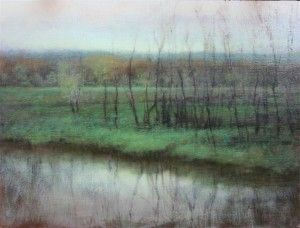
Nancy Bush, Alligator Haven, Aransas Wildlife Refuge, oil, 18 x 24.
She came across a picturesque bend in a stream fringed by drying grasses, where leafless trees stood sentry on the horizon. “Here in Fredericksburg,” she laughs when asked which particular waterway it was, “there’s a stream around every corner.” Though she is well versed in plein-air techniques, she didn’t whip out her paint box to capture the quick color reference sketch she’ll often make under other circumstances. “At this time of day, there’s simply not enough time to do anything like that. The light goes within seconds,” she says. Instead she turned her digital camera to the scene, firing shot after shot.
But an even more important recording device was called into action as well: Bush’s memory. “I’m always taking mental notes, not just of what I’m seeing but, more importantly, what I’m feeling,” she says.
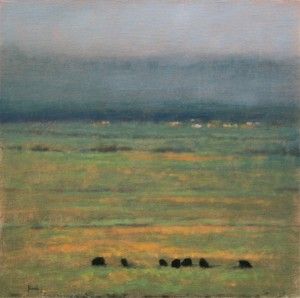
Nancy Bush, Lifting Mist, oil, 16 x 16.
Days later, back in the attached 600-square-foot studio behind the home she shares with Bill, her husband of 28 years, memory took charge as Bush began to apply layer after thin layer of subdued hues to achieve the phenomenal depth of the 36-by-40-inch oil she calls AUTUMN TWILIGHT. “I always ask myself, ‘What is my intention in this painting? What do I want to say? What do I want the person who views my painting to see or feel?’” she says. “This one is about describing the beauty of the very late light, just before dark, and how it reflects in the water.”
That particular painting stands as a perfect example of Bush’s impressive, growing body of work. She proudly places her oeuvre in the traditions of tonalism, a style that developed in the late 19th and early 20th centuries among American artists including James McNeill Whistler and George Inness. They strived to capture not merely the geography and vegetation of rural scenes but also their mood, their atmosphere. They often did so by carefully evoking—using a palette of relatively neutral tones—low-light conditions filtered by rain, mist, or fog.
Bush possesses a sure grasp of tonalism’s power, and she’s eager to explain why the style so appeals to her sensibilities. “There are true elements of nature that we sometimes don’t really see. We’ll just catch a glimpse of them,” she says. “I want to make the viewer not only see what I’ve seen but feel what I’ve felt—the coldness of the snow, the mystery of the fog. Tonalism is about capturing that fleeting, quiet moment, an atmosphere that’s difficult to describe in words.” Oil paints, however—especially when handled by someone who has worked hard to achieve tonalist mastery over the medium—can make possible what mere words cannot.
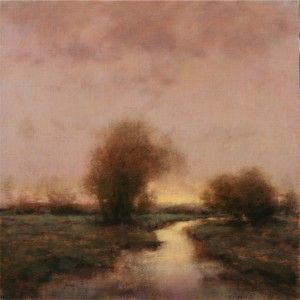
Nancy Bush, Clearing Storm, oil, 16 x 16.
For an accomplished artist whose works have received awards in major art shows, Bush’s earliest aesthetic efforts were surprisingly inauspicious. Unlike many budding artists, who win school prizes and—especially in Texas—are drafted to create pep-rally posters and run-through banners for the high-school football team, she kept her own light securely under a bushel during her 1950s childhood in Austin. “I was very shy and did all of my art at home, drawing, always drawing,” she recalls of her pencil-sketch portraits and her fashion drawings inspired by the great movie costume designer Edith Head. “I never showed my work to anyone.”
Nevertheless, she received artistic inspiration from an unlikely source: her great-uncle Ralph Rowntree, a renowned portrait and still-life artist working in pastels. “He was a very eccentric person, quite the bon vivant, who ran with New York society and Hollywood people,” she recalls. “When he moved back to Texas in the 1950s, he had studios in Austin and San Antonio, and when he was in town we would go to visit him. From the age of 8 or 9 until we moved when I was 14, he would allow me to watch him work, which was a real treat. He never really included me in any conversation, and I can’t say that he ever encouraged me. But I held him in awe. Being around him was very interesting. I was amazed that one could produce such beauty, and I always thought it was what I wanted to do.”
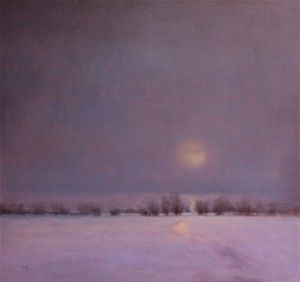
Nancy Bush, Veiled Moon, oil, 28 x 30.
Though she dreamed of becoming a portrait painter, Bush followed a more practical, less aesthetic plan after high school. “My family did not really support the idea of art for me,” she matter-of-factly says. Instead, she enrolled in community college, where she studied real estate and business. She got married and had two children, did part-time office work, and eventually divorced. She worked in real estate. And her artistic aspirations stayed on hold.
Then, she met, fell in love with, and married Bill Bush, a partner with a top accounting firm. “And he was the catalyst in helping me to get where I’d always wanted to be,” she says. “Bill has always been my encourager, my light. He’s my right arm, my everything, helping me to achieve and attain what my dream was and is, and he is the biggest and best supporter anyone could ever have.”
Hearing Nancy talk of her dream of being an artist, Bill “led me to the phone,” she says. He encouraged her to sign up for a beginners’ class at a local art school in Austin. Alas, that experience wasn’t exactly what she’d been hoping for. “It was all a very contemporary, ‘express yourself’ kind of class,” she says. “I didn’t feel I was getting anywhere.” After sticking with it for the full six weeks, she found another course more to her liking, one that offered a more serious classical-style curriculum. Three days a week for a year, she studied “line and light and shadow and form. We copied a lot of the old masters. For a very long time, we worked just in pencil and charcoal, and only toward the end did we graduate to color. I couldn’t get enough of it,” she says.
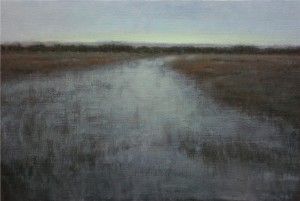
Nancy Bush, Marshland, oil, 20 x 30.
Next, Bush began avidly taking workshops. Her first was a weeklong class taught in Austin by renowned Taos-based artist Ray Vinella, and she continued to take more workshops from him regularly over the next five years. “He was the most supportive mentor,” she says. Beyond the wealth of technical lessons she learned from him, her most important takeaway was one of attitude. “He instilled confidence in me. ‘There is no failure,’ he told me. ‘Each painting is a lesson, and you’re growing from each one,’” Bush says.
Under his tutelage, Bush also began to shift to landscapes as her preferred subject, rather than the portraits she’d always loved. This new focus allowed for greater flexibility and creativity in composition. “You didn’t have to be so exact with a landscape,” she laughs. “You could move trees or streams, or even mountains, where you wanted them.” Landscapes, in turn, led her down the tonalist path. “I was drawn to quieter, more atmospheric situations rather than bright colors, and Ray encouraged me there,” she says. Several workshops with Utah-based tonalist Michael Workman further helped her grasp the style’s principles and techniques, and by the mid-1990s, Bush considered herself a tonalist in her own right.
That was around the time the Bushes moved to Fredericksburg. “We decided it was going to be the place,” she says. “It was just the beauty of the Hill Country.” Bill established the Fredericksburg Artists’ School, which has grown to become one of the nation’s most respected centers for workshops taught by leading representational artists. And Nancy, meanwhile, saw her diligent studies begin to yield tangible results.
Twice around that time, she had a painting chosen to be among the top hundred in the prestigious Arts for the Parks exhibition. Similar successes in other shows and competitions gradually drew invitations from galleries, including a prized one early on to join the stable at the respected Nedra Matteucci Fine Art gallery in Santa Fe. She stayed with that gallery for 18 years, until it closed in late 2010.
Yet, for all her hard-won public successes, Bush views her greatest accomplishment as something far more personal. “I think the joy of being able to go to my studio and do what I love is the real landmark,” she says of the hours she now spends every day at her easel, surrounded by hundreds of books on tonalists, impressionists, and other artists she admires. “When I have trouble with a passage in a painting, I always go to my books for inspiration,” she explains. “Painting is a never-ending process of education.”
Of course, she appreciates the fact that her works are so much in demand. “People liking what I do and coming to my shows and buying my paintings is a real blessing,” she says, her voice humbly hushed. “But painting is my passion. So everything else is just icing on the cake.”
representation
InSight Gallery, Fredericksburg, TX; Astoria Fine Art, Jackson, WY; Dawson Cole Fine Art, Laguna Beach, CA; M Gallery of Fine Art, Charleston, SC; Worrell Gallery, Santa Fe, NM; Mountainsong Galleries, Carmel, CA; www.nancybush.com.
Featured in the May 2013 issue of Southwest Art magazine–click below to purchase:
Southwest Art May 2013 digital download
Southwest Art May 2013 print issue
Or subscribe to Southwest Art and never miss a story!
- Nancy Bush, Alligator Haven, Aransas Wildlife Refuge, oil, 18 x 24.
- Nancy Bush, April’s Gift, oil, 12 x 12.
- Nancy Bush, Ascending Moon, oil, 11 x 14.
- Nancy Bush, At Sunset, oil, 20 x 24.
- Nancy Bush, Autumn into Winter, oil, 24 x 30.
- Nancy Bush, Autumn Twilight, oil, 36 x 40.
- Nancy Bush, Clearing Storm, oil, 16 x 16.
- Nancy Bush, Foggy Pond, oil, 20 x 20.
- Nancy Bush, Lifting Mist, oil, 16 x 16.
- Nancy Bush, Marshland, oil, 20 x 30.
- Nancy Bush, Moonrise at Sunset, oil, 18 x 24.
- Nancy Bush, Showers in Maestas, oil, 30 x 36.
- Nancy Bush, Summer Rain, oil, 30 x 36.
- Nancy Bush, Veiled Moon, oil, 28 x 30.
- Nancy Bush, Winter Pond, oil, 12 x 12.
MORE RESOURCES FOR ART COLLECTORS & ENTHUSIASTS
• Subscribe to Southwest Art magazine
• Learn how to paint & how to draw with downloads, books, videos & more from North Light Shop
• Sign up for your Southwest Art email newsletter & download a FREE ebook






